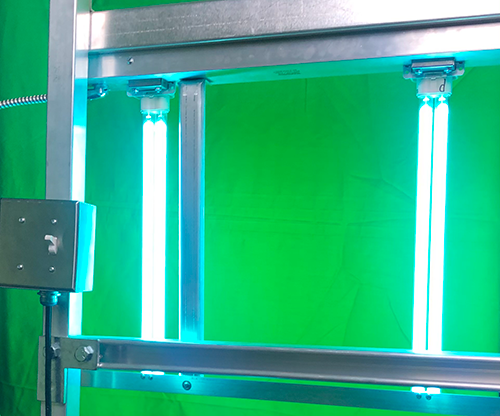How Does UV Light Sanitize COVID 19 Coronavirus?
How Ultraviolet Light Could Help Stop The Spread Of Coronavirus
UVGI Covid-19 Response Plan
How You Can Protect Your Staff and Others and Slow the Spread
Create a COVID-19 workplace health and safety plan.
- Start by reviewing the CDC Interim Guidance for Businesses and Employers.
Before resuming business operations, check the building to see if it’s ready for occupancy.
- Evaluate the building and its mechanical and life safety systems to determine if the building is ready for occupancy. Check for hazards associated with prolonged facility shutdown such as mold growthexternal icon, rodents or pestspdf iconexternal icon, or issues with stagnant water systems, and take appropriate remedial actions.
- Ensure that ventilation systems in your facility operate properly. For building heating, ventilation, and air conditioning (HVAC) systems that have been shut down or on setback, review new construction startup guidance provided in ASHRAE Standard 180-2018, Standard Practice for the Inspection and Maintenance of Commercial Building HVAC Systemspdf iconexternal icon.
- Increase circulation of outdoor air as much as possible by opening windows and doors if possible, and using fans. Do not open windows and doors if doing so poses a safety or health risk for occupants, including children (e.g., a risk of falling or of breathing outdoor environmental contaminants such as carbon monoxide, molds, or pollens).
- To minimize the risk of Legionnaires’ disease and other diseases associated with water, take steps to ensure that all water systems and features (e.g., sink faucets, drinking fountains, decorative fountains) and water-using devices (e.g., ice machines, cooling towers) are safe to use after a prolonged facility shutdown.
Identify where and how workers might be exposed to COVID-19 at work.
Employers are responsible for providing a safe and healthy workplaceexternal icon.
- Conduct a thorough hazard assessmentexternal icon of the workplace to identify potential workplace hazards that could increase risks for COVID-19 transmission.
- Identify work and common areas where employees could have close contact (within 6 feet) with others — for example, meeting rooms, break rooms, the cafeteria, locker rooms, check-in areas, waiting areas, and routes of entry and exit.
- Include all employees in communication plans — for example, management, staff, utility employees, relief employees, janitorial staff, and maintenance staff.
- If contractors are employed in the workplace, develop plans to communicate with the contracting company about changes to work processes and requirements for the contractors to prevent transmission of COVID-19.
Develop hazard controls using the hierarchy of controls to reduce transmission among workers. Use a combination of controls noted below.
Engineering controls: Isolate workers from the hazard
- Modify or adjust seats, furniture, and workstationspdf iconexternal icon to maintain social distancing of 6 feet between employees, where possible.
- Install transparent shields or other physical barriers where possible to separate employees and visitors where social distancing is not an option.
- Arrange chairs in reception or other communal seating areas by turning, draping (covering chair with tape or fabric so seats cannot be used), spacing, or removing chairs to maintain social distancing.
- Use methods to physically separate employees in all areas of the building, including work areas and other areas such as meeting rooms, break rooms, parking lots, entrance and exit areas, and locker rooms.
- Use signs, tape marks, or other visual cues such as decals or colored tape on the floor, placed 6 feet apart, to show where to stand when physical barriers are not possible.
- Replace high-touch communal items, such as coffee pots and bulk snacks, with alternatives such as pre-packaged, single-serving items. Encourage staff to bring their own water to minimize use and touching of water fountains or consider installing no-touch activation methods for water fountains.
- Consider taking steps to improve ventilation in the building, in consultation with an HVAC professional, based on local environmental conditions (temperature/humidity) and ongoing community transmission in the area:
- Increase the percentage of outdoor air, (e.g., using economizer modes of HVAC operations) potentially as high as 100% (first verify compatibility with HVAC system capabilities for both temperature and humidity control as well as compatibility with outdoor/indoor air quality considerations).
- Increase total airflow supply to occupied spaces, if possible.
- Disable demand-control ventilation (DCV) controls that reduce air supply based on temperature or occupancy.
- Consider using natural ventilation (i.e., opening windows if possible and safe to do so) to increase outdoor air dilution of indoor air when environmental conditions and building requirements allow.
- Improve central air filtration:
- Increase air filtrationexternal icon to as high as possible without significantly diminishing design airflow.
- Inspect filter housing and racks to ensure appropriate filter fit and check for ways to minimize filter bypass.
- Consider running the HVAC system at maximum outside airflow for 2 hours before and after occupied times, in accordance with industry standardsexternal icon.
- Generate clean-to-less-clean air movements pdf iconexternal iconby re-evaluating the positioning of supply and exhaust air diffusers and/or dampers and adjusting zone supply and exhaust flow rates to establish measurable pressure differentials. Have staff work in “clean” ventilation zones that do not include higher-risk areas such as visitor reception or exercise facilities (if open).
- Consider using portable high-efficiency particulate air (HEPA) fan/filtration systems to help enhance air cleaningpdf iconexternal icon (especially in higher-risk areas).
- Ensure exhaust fans in restroom facilities are functional and operating at full capacity when the building is occupied.
- Consider using ultraviolet germicidal irradiation (UVGI)pdf iconexternal icon as a supplemental technique to inactivate potential airborne virus in the upper-room air of common occupied spaces, in accordance with industry guidelines.
Administrative controls: Change the way people work
- Encourage employees who have symptoms of COVID-19 or who have a sick family member at home with COVID-19 to notify their supervisor and stay home.
- Employees who appear to have symptoms when they arrive at work or who become sick during the day should immediately be separated from others, provided a face mask if they are not using one, and sent home with instructions and guidance on how to follow-up with their healthcare provider.
- Sick employees should follow CDC-recommended steps. Employees should not return to work until they meet the criteria to discontinue home isolation, in consultation with their healthcare provider.
- Perform enhanced cleaning and disinfection after anyone suspected or confirmed to have COVID-19 has been in the workplace.
- Consider conducting daily in-person or virtual health checks (e.g., symptoms and/or temperature screening) of employees before they enter the work site.
- See CDC’s COVID-19 General Business FAQs for guidance on how to safely conduct employee screening.
- Develop and implement a policy to prevent employees from gathering in groups while waiting for screening, and maintain a 6-foot separation between employees.
- Alternatively, consider having employees perform self-checks at home before heading to the office.
- Stagger shifts, start times, and break times as feasible to reduce the number of employees in common areas such as screening areas, break rooms, and locker rooms.
- Consider posting signs in parking areas and entrances that ask guests and visitors to phone from their cars to inform the administration or security when they reach the facility.
- Provide directions for visitors to enter the building at staggered times.
- Consider posting signs in parking areas and entrances that ask guests and visitors to wear cloth face coverings if possible, to not enter the building if they are sick, and to stay 6 feet away from employees, if possible.
- Clean and disinfect high-touch surfaces.
- Follow the Guidance for Cleaning and Disinfecting to develop, follow, and maintain a plan to perform regular cleanings of surfaces to reduce the risk of people’s exposure to the virus that causes COVID-19.
- At least daily, clean and disinfect all surfaces that are frequently touched by multiple people, such as door handles, desks, light switches, faucets, toilets, workstations, keyboards, telephones, handrails, printer/copiers, and drinking fountains. More frequent cleaning and disinfection may be required based on level of use.
- If hard surfaces are dirty, clean them using a detergent or soap and water before you disinfect them.
- Disinfect using products that are EPA-approved for use against the virus that causes COVID-19.external icon Follow the manufacturer’s instructions for all cleaning and disinfection products (e.g., concentration, application method, and contact time).
- If products on EPA’s List N: Disinfectants for Coronavirus (COVID-19)external icon are not available, bleach solutions can be used if appropriate for the surface and will be effective against coronaviruses when properly diluted. Most household bleach contains 5%–9% sodium hypochlorite. Do not use a bleach product if the percentage is not in this range or is not specified, such as some types of laundry bleach or splash-less bleach as these are not appropriate for disinfection.
- Follow the directions on the bleach bottle for preparing a diluted bleach solution. If your bottle does not have directions, you can make a bleach solution for disinfecting by mixing:
- 5 tablespoons (1/3 cup) of bleach per gallon of room temperature water OR
- 4 teaspoons of bleach per quart of room temperature water
- Follow the manufacturer’s application instructions for the surface. If instructions are not available, leave the diluted bleach solution on the surface for at least 1 minute before removing or wiping. This is known as the “contact time” for disinfection. The surface should remain visibly wet during the contact time.
- Ensure proper ventilation during and after application (for example, open windows).
- Never mix household bleach (or any disinfectants) with any other cleaners or disinfectants. This can cause vapors that may be very dangerous to breathe in.
- Make a new diluted bleach solution daily. Bleach solutions will not be as effective after being mixed with water for over 24 hours.
- Give employees enough time to wash and dry their hands and provide accessible sinks, soap, water, and a way to dry their hands (e.g., paper towels, hand dryer).
- Remind employees to wash their hands often with soap and water for at least 20 seconds. If soap and water are not available, they should use hand sanitizer with at least 60% alcohol.
- Establish policies and practices for social distancing:
- Remind employees that people may be able to spread COVID-19 even if they do not show symptoms. Consider all close interactions (within 6 feet) with employees, clients, and others as a potential source of exposure.
- Discourage handshaking, hugs, and fist bumps.
- Encourage the use of outdoor seating areas and social distancing for any small-group activities such as lunches, breaks, and meetings.
- For employees who commute to work using public transportation or ride sharing, consider offering the following support:
- If feasible, offer employees incentives to use forms of transportation that minimize close contact with others (e.g., biking, walking, driving or riding by car either alone or with household members).
- Ask employees to follow the CDC guidance on how to protect yourself when using transportation.
- Allow employees to shift their hours so they can commute during less busy times.
- Ask employees to wash their hands as soon as possible after their trip.
- Post instructions and reminders at entrances and in strategic places on hand hygiene, COVID-19 symptoms, wearing cloth face coverings, and cough and sneeze etiquette. This should include signs for non-English speakers, as needed.
- Use no-touch trash cans when possible.
- Remind employees to avoid touching their eyes, nose, and mouth.





